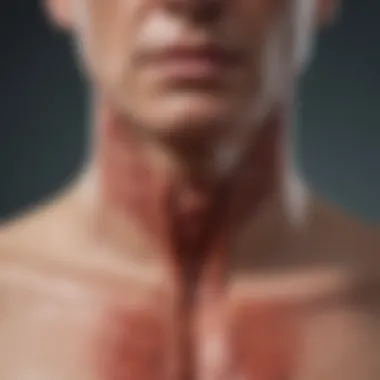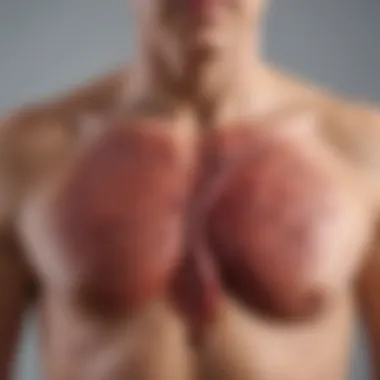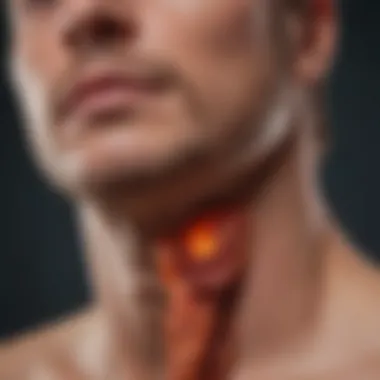The Connection Between Liver Disease and Itching


Intro
The intersection of liver disease and itching is a vital subject within the medical field. Pruritus, or itching, can be one of the more distressing manifestations of liver dysfunction. Understanding the underlying mechanisms is crucial, as it not only informs treatment but also offers insight into the severity of liver disease. As medical professionals and researchers explore this connection, we can better comprehend how liver health impacts overall well-being.
This article aims to shed light on the relationship between various liver diseases and the symptom of itching, also known as pruritus. We will analyze the physiological processes involved, review different types of liver diseases associated with itching, and examine potential treatment options. The implications of this exploration extend beyond academic curiosity; they hold significant relevance for clinical practice and patient management.
Research Overview
Methodological Approaches
In studying the connection between liver disease and pruritus, researchers utilize a variety of methodological approaches. Clinical studies often focus on patient populations, aiming to quantify the prevalence of itching in individuals with different liver conditions. Surveys and questionnaires can elicit self-reported data on the severity and duration of itching, ultimately constructing a clearer picture of the symptom's impact. Laboratory studies delve into the biochemical pathways involved in liver disease, highlighting the role of bile acids, cytokines, and other mediators.
Significance and Implications
The link between liver disease and itching carries significant clinical implications. Recognizing itching as a symptom can lead to earlier diagnosis and treatment of liver conditions. Furthermore, understanding the various factors that contribute to pruritus can help inform therapeutic strategies. Ultimately, enhancing the quality of life for patients suffering from liver-related itching is a crucial goal for healthcare providers. It is this need for improved patient care that underscores the importance of ongoing research in this area.
Current Trends in Science
Innovative Techniques and Tools
Scientists are developing innovative techniques to better understand the mechanisms of itching associated with liver disease. Advances in imaging technologies allow for real-time visualization of liver functions and related symptoms. Biochemical assays are becoming more sophisticated, revealing insights into the specific mediators involved in pruritus. These advancements can lead to tailored therapies aimed at alleviating symptoms in patients.
Interdisciplinary Connections
The study of liver disease and itching is not isolated. It intersects with multiple areas of research, including dermatology, pharmacology, and immunology. This interdisciplinary approach can yield richer insights into how liver dysfunction affects the skin, guiding the development of more effective treatments. By fostering collaboration between these fields, researchers can address the complexities of pruritus more comprehensively and effectively.
Intro
The connection between liver disease and itching is a topic that warrants careful examination. Itchiness, scientifically referred to as pruritus, often serves as a silent indicator of underlying liver dysfunction. This article will delve into the nature of this relationship, exploring the significance of understanding how liver problems can manifest through skin irritation.
Pruritus is not merely a discomfort; it is a symptom that can greatly affect the quality of life for those suffering from liver conditions. Recognizing its origins can lead to better patient management and treatment strategies. Therefore, a thorough exploration of this phenomenon is essential for both medical professionals and individuals dealing with liver disease.
Overview of Liver Disease
Liver disease encompasses a wide range of disorders that affect the liver's structure and function. The liver plays an integral role in various metabolic processes, including detoxification, protein synthesis, and the production of biochemicals necessary for digestion. When the liver is compromised, these functions can be severely impaired, leading to serious health consequences.
Common types of liver disease include hepatitis, cirrhosis, and fatty liver disease. Each of these conditions arises from different causes, such as viral infections, alcohol consumption, or metabolic disorders. The liver's response to these insults can result in inflammation, scarring, or complete failure, each presenting a unique set of challenges. This complexity highlights the importance of understanding liver health, as damage to this organ can significantly alter overall well-being.
Understanding Pruritus
Pruritus is a multifaceted symptom that is often misunderstood. It can be caused by various factors, and its relationship with liver disease adds another layer of complexity. In individuals with liver dysfunction, the build-up of bile salts and other substances in the bloodstream can trigger an intense itch. This connection underscores the need for healthcare providers to be aware of the potential for itching in patients diagnosed with liver disease.
Itching may also have psychological components, contributing to stress and anxiety for patients. This emotional aspect should not be overlooked when addressing pruritus. Providing comprehensive care involves not only treating the underlying liver condition but also managing the associated symptoms to enhance patients' quality of life.
Physiology of Itching in Relation to Liver Disease
The physiology of itching, also known as pruritus, plays a crucial role in understanding how liver disease manifests. Itching is not merely a skin issue. It is a complex physiological response often linked to systemic conditions, particularly liver dysfunction. Increased awareness about this connection is necessary for both effective diagnosis and treatment of the underlying liver issues.


The presence of itch in liver diseases is generally attributed to abnormal biochemical processes related to liver dysfunction. When the liver is compromised, it might fail to adequately filter bile salts and toxins from the bloodstream. This leads to their accumulation in the body, specifically affecting the skin receptors responsible for sensation. Recognizing this relationship facilitates a more targeted approach in evaluating patients.
Bile Salts and Itching
Bile salts are organic compounds produced by the liver to aid digestion. They assist in the emulsification of fats and have a role in the absorption of fat-soluble vitamins. In liver disease, altered bile acid metabolism leads to elevated serum bile salt levels. This accumulation is a significant contributor to pruritus.
When bile salts circulate in the bloodstream, they can stimulate nerve endings in the skin. These nerve endings transmit signals to the brain, resulting in an itchy sensation. The mechanisms may involve the activation of specific receptors, which have yet to be fully understood. This relationship underpins the rationale for addressing bile salt levels in treating itching associated with liver disease.
The accumulation of bile salts can lead to severe itching, affecting the quality of life in patients with liver diseases.
Histamine Release Mechanisms
Histamine, a compound released by immune cells, is associated with inflammatory responses and allergic reactions. In the context of liver disease, histamine may also play an indirect role in itching. Elevated histamine levels can occur in liver dysfunction due to the liver's decreased ability to metabolize this compound. Consequently, patients may experience heightened itching as a result of this accumulation.
Histamine interacts with specific receptors in the skin, primarily receptors, leading to the sensation of itch. When liver dysfunction is present, histamine may become hyperactive, exacerbating the itching sensation experienced by patients. Understanding this relationship is vital for clinicians as antihistamines could serve as a potential treatment option.
Neurological Pathways of Itch Sensation
The sensation of itch is not solely a dermal reaction; it is also deeply rooted in the nervous system. Itch signals are processed in the spinal cord and brain, indicating the complexity of itch perception. In individuals with liver disease, these neurological pathways may be altered, leading to abnormal itch responses.
Neurological mechanisms involve various neurotransmitters and receptors that have yet to be thoroughly elucidated. Recent studies suggest that the activation of certain pathways may also contribute to the persistent feeling of itch among patients with liver dysfunction. This implies that treating the underlying liver disease alone may not eliminate the symptom of itch. Instead, addressing the neurological pathways involved may provide a more comprehensive approach to managing pruritus in these patients.
Types of Liver Disease Associated with Itching
The relationship between liver disease and the symptom of itching, known as pruritus, is multifaceted and warrants a detailed examination. Understanding the types of liver diseases that manifest this symptom is vital for healthcare practitioners, patients, and researchers alike. Each type of liver disease can present unique challenges in both diagnosis and management, making it essential to identify such conditions early. This section will delve into the specifics of various liver diseases where itching is a common symptom, exploring their mechanisms and clinical implications.
Cholestatic Liver Diseases
Cholestatic liver diseases are a group of disorders characterized by impaired bile flow. When bile cannot properly exit the liver, it accumulates, leading to increased concentrations in the bloodstream. This retention of bile acids is frequently associated with persistent itching. Common conditions in this category include primary sclerosing cholangitis and primary biliary cholangitis. The underlying pathology often results in significant liver damage if left untreated. Understanding the mechanisms behind cholestasis and its linkage to pruritus is essential for developing targeted therapies aimed at alleviating itching symptoms.
Hepatitis and Its Symptomatic Effects
Hepatitis, an inflammation of the liver, can stem from various causes, including viral infections, alcohol use, and autoimmune disorders. Patients with hepatitis often experience multiple symptoms, including fatigue, jaundice, and itching. The itch associated with hepatitis is believed to arise from various factors, including the buildup of bile acids and immune-mediated processes. By recognizing hepatitis as a possible contributor to pruritus, clinicians can extend their diagnostic approach and offer more comprehensive care to affected individuals.
Liver Cirrhosis and Its Implications
Liver cirrhosis represents a critical stage of liver disease characterized by irreversible damage and fibrosis of liver tissues. Scarring disrupts normal biliary flow, leading to bile acid accumulation. Pruritus in cirrhotic patients can be severe and significantly affects quality of life. Management of itching in cirrhosis is complex. It often requires a multi-faceted approach, including managing the underlying liver condition, when possible. Understanding the link between cirrhosis and pruritus is essential for clinical pathways aimed at improving patient outcomes.
Primary biliary cholangitis
Primary biliary cholangitis (PBC) is a chronic disease where the body's immune system attacks the bile ducts, leading to cholestasis. One of the hallmark symptoms of PBC is itching, which can be debilitating. Currently, treatments focus on slowing disease progression and addressing symptoms, particularly itching. The connection between PBC and pruritus highlights the necessity for ongoing research to uncover new therapeutic targets. Investigating this link can pave the way for advancements in patient management and care.
The interplay between various liver diseases and itching illustrates the need for thorough clinical examination and tailored treatment approaches. Early recognition of symptomatic relationships can lead to improved care strategies.
Clinical Observations and Studies
The relationship between liver disease and scratching can often be understated. The clinical observations and studies surrounding pruritus open a crucial window into the clinical significance of this symptom. Understanding how pruritus manifests in liver conditions not only aids in proper diagnosis but also emphasizes the necessity for thorough assessment in patients exhibiting itchy skin.
In liver disease, itching is more than just a nuisance; it can signify underlying complications that need attention. As practitioners observe and document itching cases in patients, a pattern emerges, highlighting the interaction between liver function and skin symptoms. This section will delve into two vital subcategories: epidemiological data and specific case studies. Both reinforce the idea that itching should not be dismissed as peripheral but understood as a potential indicator of systemic health issues, particularly in the context of liver dysfunction.


Epidemiological Data on Itching
Epidemiological studies provide valuable insights into the prevalence of itching among patients with liver disease. Research indicates that approximately 25% to 50% of patients with cholestatic liver disease experience significant itching. This statistic varies based on the specific type of liver disorder. For example, individuals with primary biliary cholangitis may experience higher rates of pruritus than those with other liver conditions.
Several key points to consider:
- Increased Urgency for Screening: The presence of pruritus in patients with liver disease often necessitates more immediate screening for liver function abnormalities.
- Correlation with Severity: Studies have shown that the severity of itching is often correlated with the level of cholestasis, indicating that higher levels can lead to more intense itching.
- Demographic Variations: Different demographics may report varying experiences with itching, leading to the need for tailored approaches in treatment and management.
The recognition of these points is crucial in clinical settings, as it underscores the importance of symptomatic assessment for patients presenting with liver conditions.
Case Studies of Itching Patients
Dissecting individual cases of patients with liver disease who experience itching offers robust insights into the complexities of pruritus. Case studies can reveal diverse trajectories of itching in relation to liver conditions, three specific instances illustrate this well:
- A 45-year old male with primary sclerosing cholangitis reported distressing itching that preceded his diagnosis, emphasizing how early symptoms can guide timely testing and interventions.
- A 62-year old female with cirrhosis experienced severe itching that disrupted her daily routine. Her case highlighted the significant psychological impact of pruritus, pushing for a discussion on holistic treatment approaches that consider mental well-being.
- A 30-year old female presented with itching associated with hepatitis C where specific treatments reduced both liver inflammation and itching, illustrating the potential for dual benefit with effective management.
Understanding individual experiences of itching within liver disease can drive better patient outcomes through customized care plans.
These case studies reveal the multifactorial nature of itching in liver disease. Highlighting diverse experiences allows practitioners to develop more nuanced treatment plans that can significantly improve the quality of life for affected patients. Assessment shouldn't be limited to clinical symptoms; practitioner awareness of these psychological and social dimensions is essential to formulating an effective response to itching related to liver conditions.
Diagnosis and Assessment of Itching
Diagnosing and assessing itching, or pruritus, is crucial in understanding the extent of liver disease and its implications for patient health. Itching can severely affect quality of life, creating discomfort that may lead to neglect of other health concerns. Thus, clinicians should recognize that when a patient presents with this symptom, it may be an indicator of underlying liver dysfunction.
Proper diagnosis of pruritus involves a multi-faceted approach that combines clinical examination, patient history, and laboratory tests. This comprehensive strategy aims to identify not only the presence of itching but also its underlying causes, which can range from mild to severe liver conditions. Notably, timely diagnosis can lead to appropriate management of both the itching itself and the liver condition.
Clinical Examination Procedures
During a clinical examination, the healthcare provider will assess the patient's overall health and specifically how itching affects them. Key steps in this process include:
- Medical History: The physician will inquire about the onset of itching, its duration, severity, and any contributing factors such as stress or lifestyle changes.
- Physical Examination: An examination of the skin is performed to identify any visible signs, such as rashes or lesions, which may accompany itching. This can help distinguish between liver-related itching and other dermatological conditions.
- Observation of Symptoms: Physicians may note whether symptoms are generalized or localized, which can provide insight into potential hepatic dysfunction.
Moreover, understanding associated symptoms, such as jaundice or fatigue, is important, as they may indicate specific types of liver disease. By correlating these findings with itching, healthcare providers can form a more informed clinical picture.
Laboratory Tests for Liver Function
To further evaluate a patient's liver condition, laboratory tests play a pivotal role. Common tests include:
- Liver Function Tests (LFTs): These tests measure various enzymes and proteins in the blood, such as alanine aminotransferase (ALT) and aspartate aminotransferase (AST), which can indicate liver inflammation or damage.
- Bilirubin Levels: Elevated bilirubin can cause jaundice and is a key marker in assessing liver function related to itching.
- Coagulation Profile: Since the liver produces proteins necessary for blood clotting, abnormal results can hint at liver dysfunction.
Understanding laboratory test results is essential, as they guide clinicians in determining the most effective diagnostic and therapeutic approaches.
In summary, a detailed assessment of itching in relation to liver disease is not just about managing the symptom. It involves a robust analysis of clinical presentations and laboratory findings to ensure that underlying liver conditions are identified and addressed effectively. This approach ultimately aids in improving patient outcomes and mitigating further complications.
Treatment Options for Pruritus in Liver Disease
Pruritus, often associated with liver disease, presents not only a physical discomfort but also a significant psychological burden on patients. Understanding the treatment options available is crucial for managing this distressing symptom effectively. This section sheds light on pharmaceutical interventions and lifestyle modifications that can help alleviate itching, enhancing the overall quality of life for affected individuals.


Pharmaceutical Interventions
Pharmaceutical interventions represent a frontline approach to managing pruritus in individuals with liver disease. The selection of medications typically focuses on targeting the underlying mechanisms of itching. Here are some commonly used classes of medications:
- Cholestyramine: This bile acid sequestrant helps reduce bile acid circulation, effectively diminishing systemic levels that contribute to pruritus. Patients often report significant relief when using this medication, although gastrointestinal side effects may occur.
- Ursodeoxycholic Acid: This medication aids in promoting bile flow and can also provide symptom relief in cholestasis-related pruritus. Its usage may depend on the specific liver conditions present.
- Antihistamines: While traditionally for allergies, certain antihistamines can help reduce itch sensation, especially at night. Drowsiness is a common side effect, so careful consideration is necessary.
- Naltrexone: Emerging evidence suggests that naltrexone can be effective for treating chronic itch when other remedies prove insufficient.
- Gabapentin or Pregabalin: These medications, initially designed for neuropathic pain, have shown promise for alleviating itching in some liver disease patients. They work by modulating nerve signals responsible for itch transmission.
The choice of pharmaceutical intervention must consider the specific type of liver disease, the severity of itching, and individual patient tolerability. Physicians often tailor these treatments based on ongoing assessments of patient response and side effects.
Lifestyle and Dietary Adjustments
Alongside pharmaceutical interventions, lifestyle and dietary adjustments offer adjunctive benefits, focusing on overall wellness and itch management. Here are some effective modifications that can be implemented:
- Hydration: Maintaining adequate fluid intake may help in moisturizing the skin and reducing dryness that could exacerbate itching.
- Skin Care Regimen: Gentle skin care is essential. Emollient creams or ointments can help maintain skin hydration. Patients should avoid harsh soaps and products that might further irritate sensitive skin.
- Dietary Changes: A well-balanced diet rich in fruits, vegetables, and whole grains supports liver health. Limiting fats, especially saturated fats, can ease the liver's workload. Additionally, some patients find that avoiding certain foods like alcohol or processed items can help mitigate itching.
- Stress Management: Psychological factors can worsen the sensation of pruritus. Engaging in stress management techniques, such as meditation or yoga, can be beneficial in reducing overall discomfort.
- Clothing Choices: Wearing loose, breathable fabrics can help prevent irritation of the skin caused by friction. This simple adjustment may contribute to a greater sense of comfort.
It is vital for patients to consult healthcare providers before making significant lifestyle changes or adjustments to their current treatments. Effective management of pruritus involves a holistic approach that considers both medical and lifestyle aspects.
Future Directions in Research
Research into the connection between liver disease and pruritus is essential for advancing our understanding of this complex relationship. As clinicians and scientists strive to find effective treatments for itching associated with liver conditions, they must consider several specific elements in their explorations. This section emphasizes innovative methodologies, interdisciplinary collaborations, and the integration of patient feedback into future studies.
Innovative Treatment Approaches
The development of novel therapeutic strategies is crucial for managing pruritus in patients with liver diseases. Traditional treatments such as antihistamines and bile acid sequestrants often provide limited relief. Therefore, researchers are investigating alternative pharmacological options that may target the underlying mechanisms of itch more effectively. Some of the emerging strategies include:
- Targeting neurokinin-1 receptors: This innovative approach aims to inhibit the pathways that activate itch sensations.
- Opioid antagonists: Medications like Naltrexone show promise in reducing pruritus by blocking certain receptor pathways.
- Bile acid modulation: This treatment focuses on altering bile acid levels to minimize their contribution to discomfort.
These approaches reflect a broader shift toward precision medicine, where tailored therapies can meet individual patient needs and address the unique pathophysiological mechanisms of itching in liver disease.
Understanding Patient Experiences
Examining the patient experience of pruritus linked to liver disease is vital for informing research and treatment. Patients often report a significant impact on their quality of life due to chronic itching, and understanding these experiences can provide valuable insights into effective management strategies. Interviews and surveys can capture nuanced data on how itching affects daily activities and psychological well-being. Key areas to investigate include:
- Psychosocial impact: Discussing how itching influences relationships, sleep patterns, and mental health.
- Personal coping mechanisms: Understanding the strategies patients employ to alleviate their discomfort could inform care approaches.
- Patient-physician communication: Enhancing dialogue can help ensure that symptom management is aligned with patient priorities and preferences.
Incorporating these patient-centered perspectives into future research will foster a holistic understanding of pruritus as it relates to liver disease. Moreover, it may lead to more effective interventions that truly enhance patients’ quality of life.
Closure
The examination of the link between liver disease and itching is crucial for advancing both clinical understanding and patient care. This article has laid out the physiological pathways that connect liver dysfunction to the symptom of pruritus. Understanding these connections benefit health practitioners by informing diagnosis and treatment strategies.
Patients suffering from liver disease often face significant quality-of-life challenges due to the discomfort caused by itching. Recognizing the underlying causes can lead to more effective treatments and targeted interventions.
Summary of Key Findings
The exploration reveals several significant insights:
- Bile Salt Accumulation: Elevated levels of bile salts in the bloodstream correlate with intense itching episodes. This is especially prominent in cholestatic liver diseases.
- Complex Neurological Pathways: The itch sensation is processed through multiple neurological pathways, linking skin and liver functions in unexpected ways.
- Specific Liver Diseases: Conditions like hepatitis, cirrhosis, and primary biliary cholangitis have been particularly associated with pruritus. Each offers unique clinical challenges relating to symptom management.
- Research Gaps: Current studies highlight a need for further exploration into the mechanisms of itching in liver disease, along with comprehensive patient experiences.
Implications for Future Practice
The discussion presented in this article has several implications for future practice:
- Enhanced Diagnostic Protocols: Clinicians may improve diagnostic accuracy by considering pruritus as a key symptom of liver dysfunction. This might prompt earlier intervention in the disease progression.
- Innovative Therapeutic Strategies: There is potential for new treatments targeting the biological mechanisms of itching to be integrated into patient care. Treatments should not just address liver health but also the accompanying discomfort.
- Patient-Centered Care: A holistic approach that incorporates patient feedback about their itching can refine treatment plans and improve quality of life. This is essential for fostering trust and cooperation in clinical settings.
In summary, the interconnectedness between liver health and the sensation of itching offers crucial insights for clinical practice. As research advances, it is essential to keep patient experiences and new findings at the forefront of clinical practice and patient care strategies.



